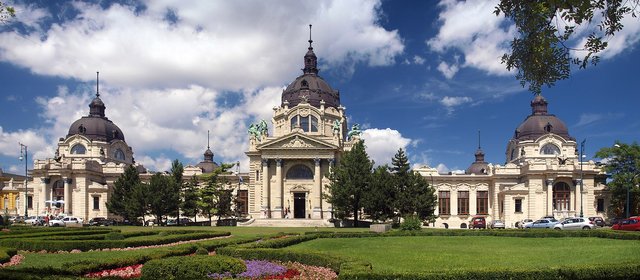European Culture Tour: Budapest's Széchenyi Thermal Bath
A city with thousands of years of history, Budapest (formerly two independent cities) lies on the Danube (Duna) River, with grand rolling hills to the west, and open plains to the east. It also happens to lie above a large area of thermal springs. It was for this reason, among others, that Romans originally settled in the area, creating the settlement of Aquincum. There have long been baths in the city for public comfort, with many actually being built during the occupation of much of Hungary by the Ottoman Turks. Since the 1920's, these spas have been popular tourist destinations as well. Perhaps one of the most beautiful baths in the city today is the expansive Széchenyi thermal bath.

Originally opened in 1913 in Budapest's grandest City Park, the complex was expanded to over 67,000 square feet ( 6,220 square metres) in 1927 to its current size. In 1938, a new well was drilled over 4,000 feet (1,256 metres ) in depth to meet the demands for water posed by the baths.

Featuring world-class Neo-Baroque architecture designed by Győző Czigler, the complex includes three large outdoor pools, and fifteen indoor pools, ranging in temperature from 64 to 100 °F (18 to 38 °C ). There are also saunas and steam rooms, often with aromatic additives, such as fruit or beer.
Medical studies of the water, which contains (among other components) sulphate, calcium, magnesium, and bicarbonate, have shown that bathing in it can help with joint pain and recovery from operations.
.jpg)

Ornately decorated, beautifully designed, and thoughtfully situated, the Széchenyi are a jewel in a city which is itself a jewel. The baths are named after Hungary's greatest statesman, known to many as "The Greatest Hungarian", István Széchenyi. Experiencing this place is truly a joyful affair. One gets the feeling that this is how humanity was supposed to interact. We lost something as a civilization between the two world wars, communism, and now. The West had a supreme dignity and confidence that it was well on the way to perfecting human existence, and life truly was improving quickly, while people did their best to be mindful of the great tradition and culture which brought them the then unprecedentedly prosperous lives they were then living. When one visits the Széchenyi baths, one recaptures a bit of that feeling, and is reinvigorated with a profound peace, and determination to improve the world and bring their civilization back to glory.
When Westerners in general visit post-communist nations, they discover in many ways a piece of what they are missing in their own countries. Those who experienced the horrors of communism directly know first-hand the importance of preserving one's cultural heritage, and the joy of passing on a happy and healthy society to their children. I strongly recommend visiting Budapest, Hungary, and many other parts of Central and Eastern Europe. It is a breath of fresh air in this sometimes gloomy world we inhabit.
Defend Western Civilization, and enjoy the beautiful fruits of it, such as the Széchenyi baths, when possible.
very nice
I greet you with nice photos and I encourage you to visit my profile :)
Hungry is one of those lovely country to visit ....nice work and great research
very good